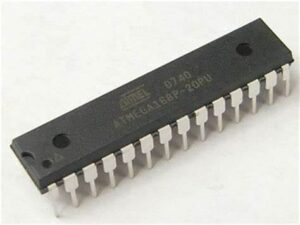Extract MCU ATmega168P Software from cracking mcu atmega168p flash memory and replicate the avr atmel processor atmega168p memory content in the format of heximal;

The interrupt execution response for all the enabled AVR interrupts is four clock cycles minimum. After four clock cycles the program vector address for the actual interrupt handling routine is executed. During this four clock cycle period, the Program Counter is pushed onto the Stack.
The vector is normally a jump to the interrupt routine, and this jump takes three clock cycles. If an interrupt occurs during execution of a multi-cycle instruction, this instruction is completed before the interrupt is served. If an interrupt occurs when the MCU is in sleep mode, the interrupt execution response time is increased by four clock cycles. This increase comes in addition to the start-up time from the selected sleep mode.
A return from an interrupt handling routine takes four clock cycles. During these four clock cycles, the Program Counter (two bytes) is popped back from the Stack, the Stack Pointer is incremented by two, and the I-bit in SREG is set.
This section describes the different memories in the ATmega168. The AVR architecture has two main memory spaces, the Data Memory and the Program Memory space. In addition, the ATmega168 features an EEPROM Memory for data storage. All three memory spaces are linear and regular.

The ATmega168 contains 4/8/16K bytes On-chip In-System Reprogrammable Flash memory for program storage. Since all AVR instructions are 16 or 32 bits wide, the Flash is organized as 2/4/8K x 16. For software security, the Flash Program memory space is divided into two sections, Boot Loader Section and Application Program Section in ATmega88 and ATmega168.
ATmega48 does not have separate Boot Loader and Application Program sections, and the SPM instruction can be executed from the entire Flash. See SELFPRGEN description in section ”SPMCSR – Store Program Memory Control and Status Register” on page 267 and page 283for more details.
The Flash memory has an endurance of at least 10,000 write/erase cycles. The ATmega48/88/168 Program Counter (PC) is 11/12/13 bits wide, thus addressing the 2/4/8K program memory locations. The operation of Boot Program section and associated Boot Lock bits for software protection are described in detail in ”Self-Programming the Flash, ATmega48” on page 262 and ”Boot Loader Support – Read-While-Write Self-Programming, ATmega88 and ATmega168” on page 269. ”Memory Programming” on page 285 contains a detailed description on Flash Programming in SPI- or Parallel Programming mode.
Constant tables can be allocated within the entire program memory address space (see the LPM – Load Program Memory instruction description). Timing diagrams for instruction fetch and execution are presented in ”Instruction Execution Timing” on page 14.

